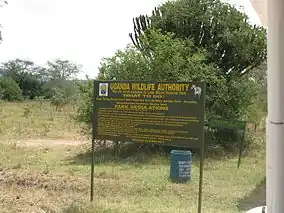Lake Mburo National Park
Lake Mburo National Park is a national park located in Nyabushozi County, Kiruhura District near Mbarara in Uganda.
| Lake Mburo National Park | |
|---|---|
IUCN category II (national park) | |
 The entrance sign to Lake Mburo National Park | |
 Location of Lake Mburo National Park | |
| Location | Nyabushozi County, Kiruhura District, |
| Nearest city | Mbarara |
| Coordinates | 00°37′40″S 30°58′00″E |
| Area | 260 km2 (100 sq mi) |
| Established | 1983 |
| Governing body | Ugandan Wildlife Authority |
| Official name | Lake Mburo-Nakivali Wetland System |
| Designated | 15 September 2006 |
| Reference no. | 1634[1] |
Location
Lake Mburo National Park is located in Kiruhura District in the Western Region of Uganda, about 30 km (19 mi) east of Mbarara and about 240 km (150 mi) by road west of Kampala.
Wildlife
Since 2005, the protected area is considered a Lion Conservation Unit.[2]
The park hosts zebra, hippopotamus, impala, warthog, common eland, African buffalo, jackal, African leopard, and over 300 bird species.
History
Lake Mburo was originally gazetted in 1933 as a controlled hunting area and upgraded to a game reserve in 1963. The Banyankole Bahima residents continued to graze their cattle in the reserve until it was upgraded to national park status in 1983. The Obote government's upgrade decision was intended, in part, to weaken the Banyankole, who supported anti-Obote rebels. It came at the time of the Operation Bonanza massacre of 300,000 people. As the evicted pastoralists were not compensated for lost grazing land or assisted with resettling, many remained hostile to the upgrade. The rangeland outside the park was subsequently subdivided into small ranges and subsistence farming plots.[3]
In 1985, the second Obote regime fell and the previous residents of Lake Mburo re-occupied the park's land, expelling park staff, destroying infrastructure, and killing wildlife. Less than half of the park's original land area was eventually re-gazetted by the National Resistance Movement government in 1986.[3]
See also
References
- "Lake Mburo-Nakivali Wetland System". Ramsar Sites Information Service. Retrieved 25 April 2018.
- IUCN Cat Specialist Group (2006). Conservation Strategy for the Lion Panthera leo in Eastern and Southern Africa. Pretoria, South Africa: IUCN.
- Mallarach, Josep-Maria (2008). Protected landscapes and cultural amb [i.e. and] spiritual values. Heidelberg: World Conservation Union. pp. 132–134. ISBN 3925064605.
External links
| Wikimedia Commons has media related to Lake Mburo National Park. |
| Wikivoyage has a travel guide for Lake Mburo National Park. |
- Giraffes will be translocated to Lake Mburo National Park
- Official government site
- Lake Mburo Information Portal
- Lake Mburo National Park Official Website
- Lion escapes from Lake Mburo national park, injures three people before being gunned down
- UWA Translocate 15 Giraffes to Lake Mburo National Park